Breeder Birds: Insights into Avian Breeding Practices

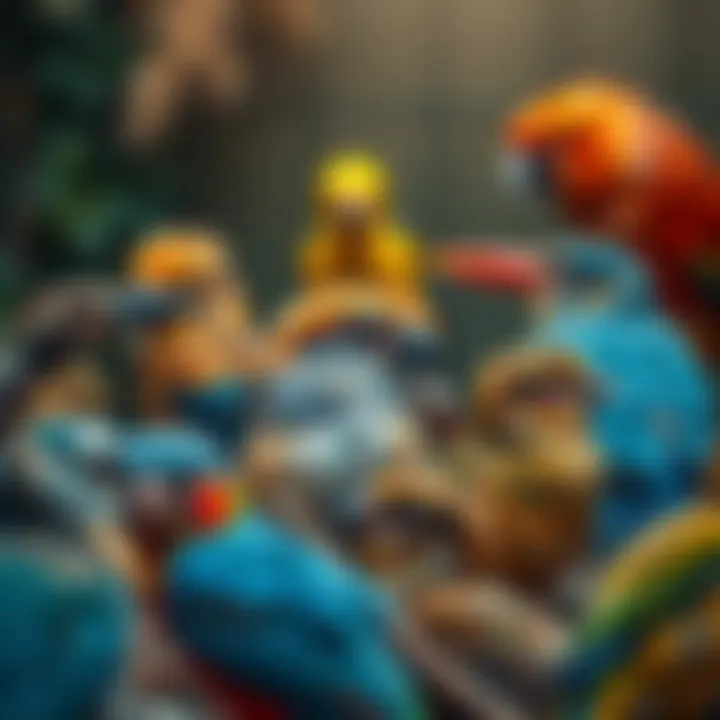
Overview of the Topic
Bird breeding serves as a crucial intersection between science, ethics, and conservation. The realm of breeder birds encapsulates various facets— from the selection of desirable traits to the preservation of endangered species. Understanding these practices provides insights into how humans interact with avian life, influencing not just animal husbandry but entire ecosystems. The significance lies beyond mere reproduction; it addresses biodiversity conservation, genetic diversity, and the collaborative efforts necessary to sustain these populations.
Breeder birds attract various stakeholders, including aviculturists, conservationists, and researchers. They all play a role in ensuring the survival of various species, and the practices employed range from traditional methods to cutting-edge genetic interventions. The knowledge ecosystem thrives on sharing best practices, learning from successes, and navigating the ethical complexities of avian breeding.
Current Status and Challenges
The landscape of avian breeding faces significant challenges today. A number of species are dwindling due to habitat loss, climate change, and poaching, leading to a pressing need for carefully managed breeding programs.
Among the critical issues are:
- Genetic Homogeneity: Breeding efforts often focus on a limited genetic pool, risking the creation of offspring with health issues. This is most pressing in captive populations.
- Ethical Dilemmas: The question of whether humans should interfere in natural processes inevitably arises. Some argue that breeding for certain traits can compromise animal welfare.
- Regulatory Barriers: Different regions have varied laws regarding species protection, making cooperation between breeders and conservationists difficult. Understanding these regulations can be a minefield, particularly for newcomers.
Identifying and addressing these challenges is key for both the future of avian preservation and the ethical practice of breeding birds.
Sustainable Solutions
Sustainable practices are essential to overcome the current challenges in avian breeding. Efforts should focus not only on breeding but also on habitat restoration and education.
- In-situ and Ex-situ Conservation: Breeding within natural habitats, alongside collaborative breeding programs in controlled settings, can bolster species survival.
- Gene Banks: Establishing genetic repositories can offer solutions for long-term preservation. These banks store genetic material that can be used later to enhance genetic diversity during breeding efforts.
- Community Engagement: Educating local communities about the importance of breeding programs can lead to more robust conservation efforts. Facilitating workshops or partnerships with local schools may yield grassroots support.
One positive case study is the recovery of the California Condor, a species brought back from the brink of extinction through dedicated breeding programs and habitat restoration efforts. These strategies blend practical action with ethical considerations, showing promise in the face of adversity.
Impact and Importance
The implications of effective breeding practices are vast. They affect not only avian species but also ecosystems and human communities. Breeding efforts contribute to biodiversity, which is crucial for ecosystem balance. Without a diversity of species, natural habitats suffer, leading to negative ripple effects across food chains and local economies.
Handling species extinction through responsible breeding has generational significance. Protecting these birds not only supports the environment but also preserves cultural heritage, as many communities hold deep connections to the avian varieties local to their regions.
"If we don't take steps to repopulate endangered species, we may never know what we’ve lost and their place in our ecosystems."
Preamble to Breeder Birds
Bird breeding is not just a niche hobby; it's an intricate dance of genetics, care, and responsibility. Whether you’re a conservationist looking to bolster endangered populations or merely a bird enthusiast, understanding breeder birds unlocks an entire universe of possibilities and challenges. This section is your gateway into the heart of avian breeding practices, shedding light on both historical and contemporary perspectives.
Breeder birds serve various purposes, from contributing to biodiversity to providing companionship. Knowing how to cultivate these creatures comes with its own set of considerations and ethics. The well-being of the birds, genetic variation, and environmental impacts are not just side notes; they are foundational principles that should guide every breeder.
Understanding Breeder Birds
Breeder birds can be defined as those avians specifically kept for propagation purposes. They include everything from canaries to exotic parrots. One of the primary focuses for bird breeders is developing healthy stock, which involves selecting breeding pairs based on genetic backgrounds, health status, and temperament.
Factors such as diet, habitat, and management practices play significant roles in ensuring successful breeding outcomes. Birds are particularly sensitive to their environment; thus, understanding their behavioral traits is crucial. For instance, some species prefer solitary spaces for nesting, while others thrive in social settings. Recognizing these nuances is vital for any budding bird breeder.
The world of breeder birds is essentially a microcosm of environmental concerns. Each species plays a role in its respective ecosystem, whether contributing to seed dispersal or acting as pollinators. Consequently, when breeding birds, one must contemplate how such practices might affect not just the individuals, but populations and ecosystems as a whole.
Historical Context of Bird Breeding
Bird breeding didn’t pop up overnight; it has roots stretching back centuries. Historically, various cultures have revered birds, showcasing them in art, religion, and even culinary traditions. Ancient Egyptians, for instance, kept pigeons for meat and common quails as pets. Fast forward to the 19th century, where the practice saw a rise in popularity, notably in Europe. Breeders began to adopt more systematic approaches to breeding, focusing predominantly on appearance and song in species like canaries and finches.
The Victorian era saw a flourish in bird-keeping hobbies, illustrating the human fascination with avian life. This period also marked the rise of aviculture as a recognized practice, with the establishment of organizations dedicated to breeding standards. However, these advancements came with trade-offs, often leading to a focus that neglected the species’ wild counterparts.
Today, this legacy means that breeders must be more conscientious; historical practices have consequences that ripple into the present. Awareness of biodiversity loss due to overbreeding or hybridization is forcing a shift in mindset. Modern breeders now look to balance personal ambitions with ecological responsibilities, creating a complex relationship where past practices must inform future actions.
"Breeding birds is about symbiosis: how we coexist with these creatures while fostering their wellbeing and that of the environment."
In summary, understanding the dual nature of breeder birds—both as companions and members of a broader ecosystem—is essential for responsible breeding. We must carry the lessons of history into our current practices, ensuring that we breed with a consciousness that respects these avian allies.
By delving into the intricacies of breeding, we prepare ourselves to navigate the many facets that this form of animal husbandry entails. As we proceed, we will explore different types of breeder birds, the techniques involved, and the ethical implications that accompany these practices.
Types of Breeder Birds
Understanding the different types of breeder birds is crucial for anyone delving into this field. Each category brings unique characteristics, challenges, and benefits that can influence breeding practices. From conservation efforts to hobby breeding, the choices of bird species play a major role in achieving specific goals. Knowing the breeds can help to better tailor care and provide suitable environments for successful reproduction.
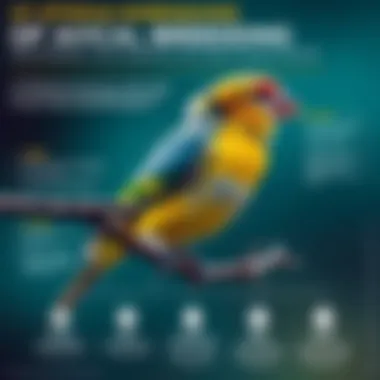
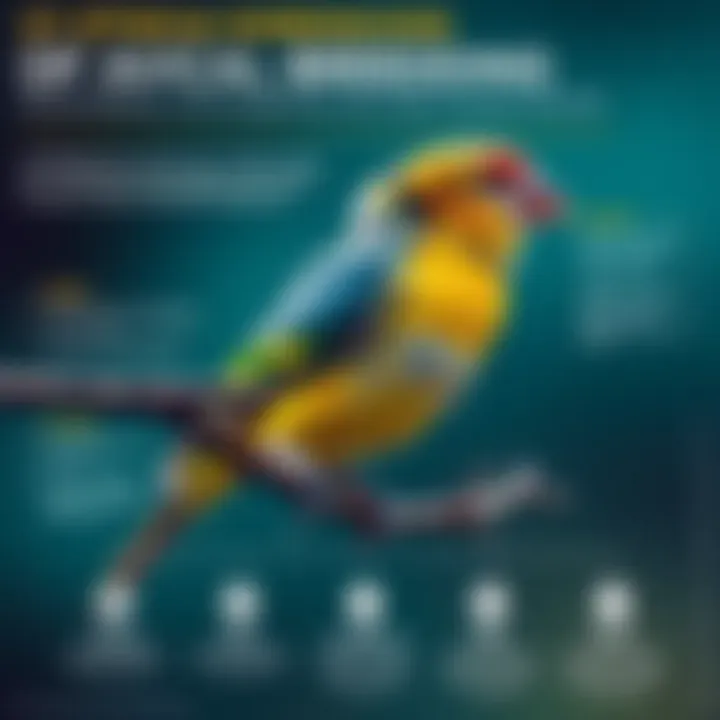
Species Commonly Used in Breeding
Birdbreeders often gravitate toward certain species for various reasons, including ease of breeding, market demand, and genetic diversity. Among the most commonly bred species are:
- Canaries: Known for their vibrant colors and sweet songs, canaries are a popular choice among both novice and experienced breeders. Their relatively straightforward breeding requirements make them suitable for those just starting out.
- Budgerigars (Budgies): These colorful little parrots are not only sociable and engaging, but they also adapt well to different environments. Due to their genetic variety, breeding budgies can lead to stunning color mutations.
- Cockatiels: Often cherished for their affectionate personalities, cockatiels are another top pick among breeders. They typically have simple breeding requirements and can thrive in a small set-up.
- Lovebirds: Their small size and spirited nature make lovebirds a popular choice, too. These social creatures need companionship, often leading breeders to keep them in pairs or groups.
The key to successful breeding lies in understanding the specific needs of each species. Breeders must also be aware of the genetic background to minimize health risks.
Wild vs. Domestic Breeder Birds
When contrasting wild and domestic breeder birds, it's essential to consider how their environments shape their reproduction habits.
Wild Breeder Birds
Wild birds have evolved in their natural habitats with specific breeding behaviors. They often exhibit strong seasonality based on climatic changes, influencing their breeding cycles. Challenges faced by wild birds include:
- Habitat Loss: Urbanization and deforestation can push wild bird populations toward endangerment.
- Food Availability: Seasonal food sources dictate the timing and success of breeding attempts.
Breeding wild birds can contribute to conservation efforts, as these practices may help replenish dwindling populations.
Domestic Breeder Birds
In contrast, domestic birds usually exhibit more flexibility in breeding. Humans have selectively bred many domestic species for specific traits, such as size, color, or temperament. Key considerations include:
- Consistent Environment: Domestic species are provided a controlled environment, allowing for year-round breeding if conditions permit.
- Genetic Manipulation: This often enhances desirable traits but carries risks of health issues and genetic defects if not managed properly.
In summary, the distinction between wild and domestic breeder birds reveals the spectrum of challenges and potentials for each. Breeders must approach each category with both creativity and caution to ensure the best outcomes.
Breeding Techniques
Understanding breeding techniques is essential in the realm of avian breeding. Not only do these methods directly influence the success of breeding programs, but they also hold significant importance for genetic diversity, health of the birds, and ultimately, conservation efforts. The effectiveness of breeding can mean the difference between thriving populations and species on the brink of extinction. Here, we delve into some of the most common breeding techniques employed by enthusiasts and professionals alike.
Natural Breeding Methods
Natural breeding involves allowing birds to pair and reproduce without human interference. Often considered the most instinctive method, it keeps the social and environmental dynamics intact.
- Pair Bonding: In nature, birds develop bonds that are crucial for successful breeding. A successful pairing leads to better parental care and higher survival rates for chicks.
- Nest Site Selection: Birds choose their own nesting sites, which are typically optimal for the environmental conditions of their habitat. This improves the chances of successfully raising offspring.
- Behavioral Observation: Natural breeding allows for the observation of behaviors that may signal readiness and compatibility among birds. This can be invaluable in selecting breeding pairs in future seasons.
However, natural breeding can also encounter challenges. Limited space, food scarcity, and environmental factors may hinder successful reproduction. Thus, while this method promotes a more authentic approach, it may not always yield consistent results across generations.
Artificial Incubation Procedures
Artificial incubation is often employed when natural conditions are unfavorable or when breeding rare species. This technique allows for greater control over the environment surrounding egg development. Here’s what you need to know about artificial incubation:
- Temperature and Humidity Control: The ability to maintain optimal temperature and humidity is crucial in ensuring embryos develop properly. Most avian eggs thrive at a temperature around 99.5°F (37.5°C).
- Turning the Eggs: In the wild, parent birds naturally turn their eggs to ensure even heat distribution. In artificial setups, mechanical or manual turning is essential to prevent embryo attachment to the shell.
- Monitoring: Frequent checks are needed to gauge the development of the eggs. Some breeders even utilize candling techniques to observe embryo growth without opening the incubator.
One crucial point to consider is the time commitment artificial incubation requires. This process can take up to several weeks, demanding vigilance from the breeder.
Genetic Manipulation in Breeding
Genetic manipulation represents a more advanced and sometimes controversial approach in breeding practices. It involves the use of technology to influence desirable traits in birds. Here are a few key aspects:
- Selective Breeding: This technique involves choosing parent birds with specific traits to enhance genetic attributes in offspring. Over generations, this can help produce birds with desired characteristics, whether it's coloration, size or resilience to diseases.
- Molecular Techniques: Advanced technologies allow breeders to understand the genetic makeup of birds at a deeper level. Techniques like CRISPR have opened new doors, enabling precise alterations to genetic codes, potentially impacting bird health and traits significantly.
- Ethical Concerns: Genetic manipulation raises ethical questions. Ensuring the welfare of the birds becomes paramount. The long-term implications on biodiversity must be deeply considered before proceeding with such interventions.
"Breeding techniques are the backbone of conservation; they can reframe the future of countless bird species, paving the way for sustainable populations across the globe."
For further knowledge, readers can explore resources such as the Cornell Lab of Ornithology and National Audubon Society. These platforms are rich with research and practical guides on avian breeding.
Ethics of Bird Breeding
The breeding of birds involves a complex network of ethical considerations, particularly in how these practices impact both the avian species themselves and the ecosystems they inhabit. This section aims to shine a light on the critical importance of ethics within bird breeding, focusing on responsible practices and the broader implications for biodiversity. Every action taken in avian breeding has ramifications that extend beyond the confines of a breeding facility or aviary, influencing genetic diversity, species survival, and ecological balance.
Responsible Breeding Practices
Responsible breeding practices are fundamental for any avian breeder who wishes to contribute positively to the breeding community. At the heart of responsible breeding lies the well-being of the birds and ensuring the integrity of their gene pools. Ethical breeders prioritize health over profit and understand that each bird represents not just a product, but a genetic legacy that can influence future populations.
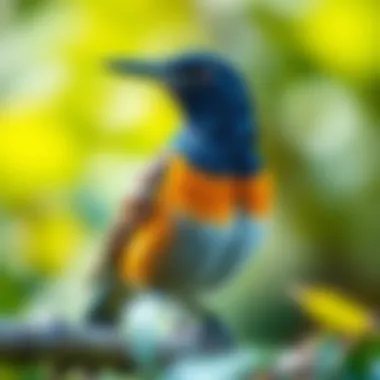
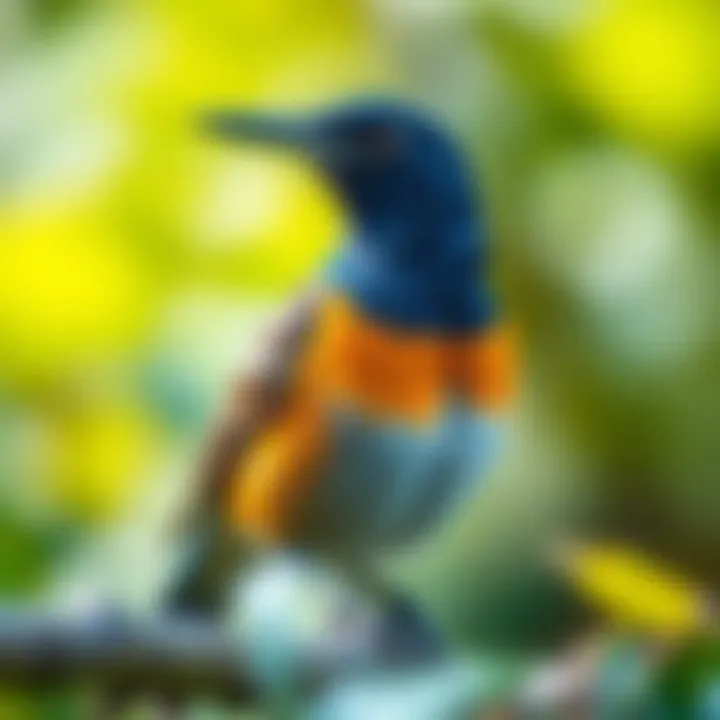
The guidelines for responsible breeding include:
- Selection of Parent Birds: Choosing healthy, genetically diverse birds is key. Breeders should research lineage and avoid inbreeding to minimize genetic defects.
- Quality of Life: Birds should be kept in spacious, clean environments that cater to their needs. Comfort and stimulation are necessary for their health and mating success.
- Transparency: Ethical breeders openly share information about their breeding practices and the health of their birds. This fosters trust and accountability within the community.
- Post-sale Support: A responsible breeder maintains a relationship with buyers to ensure that the birds are well cared for even after leaving the breeding facility.
With a focus on responsible breeding practices, the impact on the avian population can be significantly positive, enhancing genetic diversity and promoting healthier, more resilient bird populations.
Impact on Biodiversity
The role of bird breeding in conservation cannot be underestimated, yet it is fraught with responsibility. On one hand, breeding programs can aid in the recovery of endangered species, but on the other, they can unintentionally cause harm to existing biodiversity.
Breeding can impact biodiversity through several mechanisms:
- Genetic Diversity: Promoting genetic variation within breeding populations is critical. A lack of genetic diversity can lead to vulnerabilities, making species more prone to disease and environmental changes.
- Species Survival: Strategic breeding initiatives can bolster populations of endangered species, allowing them to thrive again in the wild. This has been successfully shown with birds like the California Condor and the Mauritius Kākā.
- Habitat Disruption: An excessive focus on breeding certain high-demand species may lead to habitat destruction, as facilities expand to accommodate processing large numbers of birds. This ultimately can harm natural ecosystems and other wildlife.
- Market Influence: The demand for exotic birds can create a perilous cycle. If breeding does not focus on sustainability and conservation efforts, it may encourage illegal poaching and trade, severely affecting wild populations and biodiversity.
"Breeding practices that lack ethical considerations not only threaten individual species but undermine the wider web of ecological integrity."
Challenges in Breeding Birds
Breeding birds presents a myriad of challenges that can significantly impact both the processes involved and the outcomes for avian populations. Understanding these difficulties is crucial for anyone engaged in bird breeding—whether professional or amateur. The stakes are high: failing to grapple with the challenges can lead to poor breeding results, ethical pitfalls, and detrimental effects on biodiversity. Consequently, recognizing and addressing these challenges is not merely an academic exercise; it is a fundamental aspect of responsible breeding practices.
Health Risks and Genetic Defects
Bird breeders often face a worrisome reality when it comes to health risks and genetic defects. A central concern is that inbreeding, which occurs when closely related birds are mating, can inadvertently lead to a host of genetic issues. For instance, conditions such as feather cysts, reduced fertility, and immune deficiencies may arise in populations that lack sufficient genetic diversity.
Breeders should prioritize maintaining genetic diversity to avoid these issues. Here are several steps that can be taken to ensure a healthier avian population:
- Regular Genetic Assessments: Conducting DNA tests can help identify genetic diversity and highlight any immediate issues.
- Outcrossing: Bringing in new genetic material from outside sources can help boost the population’s overall health and vigor.
- Monitoring: Routine health checks and vet consultations can catch problems early before they become widespread, thereby safeguarding the breeding stock.
"A bird's health is a reflection of its genetic background; poor choices in breeding can echo for generations."
It’s imperative not to underestimate the complexities surrounding bird genetics. Understanding these health risks is only one piece of the puzzle but is critical for sustaining future generations of breeder birds.
Market Demand and Ethical Dilemmas
Another significant hurdle faced by bird breeders lies in the tension between market demand and ethical considerations. The pet bird industry has seen a meteoric rise in popularity, leading to an increased demand for various species. This trend can sometimes push breeders to prioritize profit over ethical practices, resulting in negligent breeding methods or unsustainable practices.
Breeders might face pressures such as:
- Overproduction: To meet consumer demand, some breeders may feel compelled to produce more birds than is ethically responsible.
- Selective Breeding: While aiming for certain desirable traits, breeders can inadvertently create health risks, eroding the genetic health of the species.
- Wild Capture vs. Captive Breeding: The ethicality of harvesting birds from their natural habitats for breeding raises significant moral questions.
Role of Breeder Birds in Conservation
Bird breeding isn’t just about creating eye-catching pets or commercial birds; it plays a pivotal role in conservation efforts worldwide. The significance of breeder birds in conservation can hardly be overstated, as they help to sustain a variety of species, particularly those that are endangered or vulnerable. With the world facing unprecedented rates of species extinction due to habitat loss and climate change, breeder birds represent a lifeline for many avian species.
Breeder Birds in Endangered Species Recovery
Breeder birds are crucial for the recovery of species that are on the brink of extinction. These birds, often maintained in controlled environments, can help to preserve genetic diversity through careful breeding practices. Such efforts are particularly important for species that have seen their populations dwindle to critical numbers. By leveraging genetic knowledge, breeders can create more robust populations that can one day re-enter their natural habitats.
One shining example is the California condor, which was brought back from the edge of extinction through an extensive captive breeding program. Breeders worked diligently to ensure genetic diversity among the birds to prevent inbreeding, which can lead to health problems.
"The key to recovery is genetic diversity; a genetically healthy population has a better chance of surviving in the wild."
This underscores the point that the involvement of breeders can directly influence a species’ ability to thrive once reintroduced. In effect, breeding programs pave pathways for many birds back to the skies.
Reintegrating Breeder Birds into Natural Habitats
Reintegrating breeder birds into their native environments is a critical process that demands careful planning and execution. This process does not merely involve releasing the birds into the wild, but rather a series of steps that ensure their successful adaptation to natural living conditions.
The first step involves pre-release training, where birds from breeding programs gradually acclimatize to wild conditions. For instance, programs may simulate natural behaviors such as foraging and predator avoidance in a controlled setting. After successful training, the actual release occurs, but only after thorough assessments of habitat and food availability are conducted to ensure an optimal chance of survival.
However, the work does not stop once the birds take flight. Continued monitoring post-release is essential to track their adaptation and gather data on behaviors and survival rates. This engages not only breeders but volunteers and scientists alike, who play their parts in ensuring success stories unfold. Breeding programs that focus on rehabilitation emphasize the balance between maintaining avian populations in captivity while working towards their natural reintegration.
To delve deeper into this crucial aspect of avian conservation, resources like Wikipedia (California Condor Recovery Program) and conservation-focused platforms provide invaluable information for enthusiasts and scholars alike.

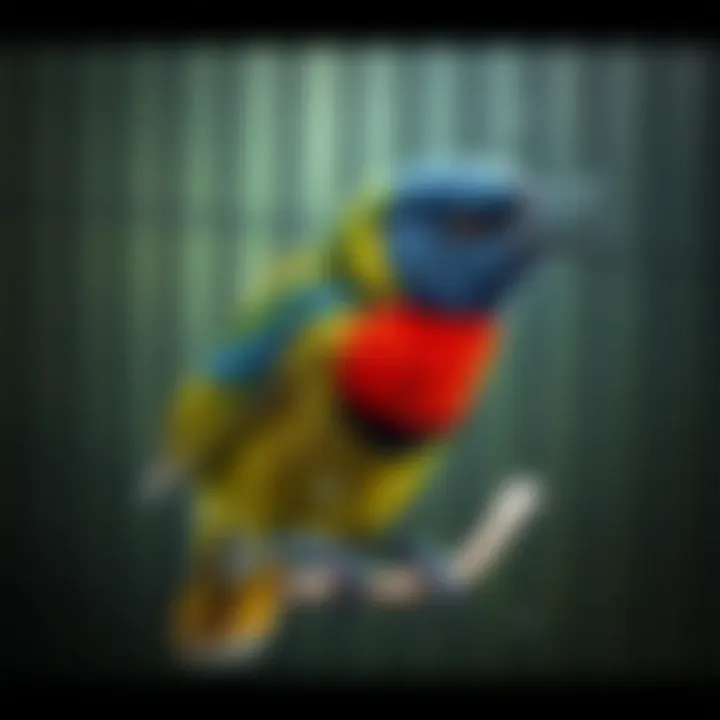
Educational Resources for Bird Breeders
When it comes to nurturing a successful breeding practice, whether one is a seasoned fancier or a newcomer, educational resources play a pivotal role. They serve as the backbone of knowledge, enabling breeders to make informed decisions that impact not just the birds they breed, but the broader sphere of avian conservation and biodiversity. In this section, we will explore some vital educational tools available for bird breeders—specifically, comprehensive books and manuals as well as engaging online courses and workshops.
Books and Manuals
Books and manuals offer an indispensable reservoir of knowledge for bird breeders. These physical and digital tomes vary in focus; some delve deep into specific species, while others cover broader breeding techniques, health management, or even the intricacies of genetics. For instance, The Breeding of Canaries by D. Smith provides insight into not only the breeding practices of these charming birds but also the potential issues that breeders might encounter, creating a solid foundation for effective husbandry.
Moreover, manuals often include vital topics such as:
- Health Care: Understanding the common avian diseases and preventive care through guidelines.
- Dietary Information: What to feed birds at different stages of their life cycle, emphasizing nutritional needs crucial for reproduction.
- Management: Techniques on how to manage breeding pairs, from housing to daily care.
Investing time in these resources not only expands one's knowledge base but also enhances the understanding of the nuances in avian breeding practices. As the well-known saying goes, "Knowledge is power," and this could not ring truer in the context of responsible breeding.
Online Courses and Workshops
In today's digital age, online courses and workshops have surged in popularity among bird breeders. They offer flexibility and a wealth of information right at one’s fingertips. Many reputable organizations and universities host courses that encompass practical skills as well as theoretical knowledge. For example, institutions like the University of Florida provide breeding workshops that focus on specific avian species, imparting hands-on experience alongside expert-led discussions.
These online educational platforms often include:
- Interactive Learning: Engaging video tutorials and live discussions where breeders can ask questions and receive real-time feedback.
- Community Engagement: Forums or social media groups where participants can share their experiences, challenges, and successes.
- Certifications: Courses that give certifications can add weight to a breeder's credibility and professionalism in the field.
Participating in these online learning opportunities can bridge the gap between theoretical knowledge and practical application, allowing for a more rounded understanding of avian breeding. As a standout benefit, they foster connections and networking among like-minded individuals passionate about avian care and conservation.
"To breed well is to be constantly learning." This sentiment embodies the journey of many bird breeders as they navigate the fascinating and sometimes daunting world of aviculture.
In summary, educational resources such as books, manuals, online courses, and workshops provide essential tools for bird breeders. By continually seeking out knowledge, breeders can contribute to both the success of their breeding endeavors and the overall health of avian species across the globe.
Future Directions in Bird Breeding Practices
The landscape of bird breeding is evolving rapidly, influenced by advances in technology, shifting ethical considerations, and an increased emphasis on sustainability. Understanding these future directions is crucial for breeders, conservationists, and environmentalists. A focus on innovative practices not only enhances breeding outcomes but also facilitates the responsible management of biodiversity.
Innovations in Breeding Technologies
Innovative techniques in breeding are not just flashy tools; they represent necessary evolution in our approach to avian breeding. For instance, technologies like CRISPR gene editing hold promise for enhancing genetic diversity. By allowing scientists to make precise changes to the genomes, this technique can potentially help in eradicating hereditary diseases that afflict certain bird species.
Another game-changer is the use of 3D printing in creating incubators and breeding environments that are tailored specifically for delicate species. For example, adaptive habitat simulations can be developed, ensuring both optimal temperatures and humidity levels are maintained for successful hatch rates.
Moreover, the integration of artificial intelligence can assist breeders in tracking genetic traits more efficiently and predicting breeding outcomes. Data analytics tools are paving the way for more informed decision-making when it comes to pairing birds for ideal genetic compensation.
Sustainable Breeding Approach
Sustainability in breeding practices is more than just a buzzword; it's a necessity for the future of avian populations. As the pressures from environmental changes and habitat destruction mount, focusing on sustainable breeding ensures that bird populations remain viable. One key aspect of this is the promotion of local species, which adapts better to local environments compared to exotic imports.
Additionally, sustainable breeding can minimize the ecological footprint. Techniques like environmentally controlled breeding facilities help in lowering resource consumption while maximizing breeding output. Coupled with conservation-oriented practices, these methods not only aid in preserving avian diversity but also enhance the wellbeing of individual birds.
In light of these sustainable methodologies, it is essential to educate and empower breeders with resources that inform about the significance of biodiversity. Connections with conservation groups and participation in community breeding programs can significantly contribute to preserving avian diversity while addressing the complexities of ecological balance.
"The future of bird breeding hinges on our ability to integrate technology with sustainable practices, bolstering conservation efforts as we navigate impending ecological challenges."
The focus on sustainable practices not only caters to individual bird species' needs but also resonates with wider conservation goals. By embracing these future directions, breeders play a pivotal role in crafting a resilient future for diverse avian populations.
End
The realm of bird breeding is not simply about producing the next generation of vibrant feathers and melodious songs; it’s a complex tapestry woven with threads of ethical concerns, genetic diversity, and the broader implications for conservation efforts. This article shines a spotlight on these intricacies, revealing how thoughtful practices can lead to both a flourishing avian population and a healthy ecosystem.
Summary of Key Insights
Throughout our exploration, several insights emerge as cornerstones in the breeding discourse:
- Diverse Breeding Techniques: From natural methods to advanced genetic manipulation, each technique serves distinct purposes based on the species and desired outcome. Understanding the benefits and limitations of these approaches is vital for success in avian breeding.
- Ethical Considerations: Responsible breeding practices cannot be overstated. Prospective breeders must navigate the delicate balance between demand and ecological impact, ensuring they contribute positively to biodiversity rather than detract from it.
- Education and Innovation: As the field evolves, so too must our knowledge. Educational resources provide invaluable tools for breeders, fostering a new generation equipped with the knowledge and skills necessary to implement sustainable practices effectively.
"The future of avian species relies not only on breeding but also on our commitment to ethical stewardship and education."
Call to Action for Ethical Breeding
As custodians of avian life, breeders hold a substantial role in shaping the ecological landscape. It is imperative that they:
- Commit to Sustainable Practices: Breeders should prioritize methods that enhance genetic diversity and reduce health risks. Utilizing techniques grounded in research and aligning with ethical standards leads to a more robust avian population.
- Engage with Community and Policy: Joining forces with conservationists, educators, and local communities can amplify the impact of breeding initiatives. Advocacy for policies that protect both wild and domestic bird species ensures a more balanced approach to avian management.
- Stay Informed and Adaptive: The environment surrounding bird breeding is ever-changing. Ongoing education and openness to innovative practices can bolster breeding efforts, making them more effective and ethically sound.
Bird breeding transcends mere pastime; it represents a vital intersection between human interest and ecological responsibility. A proactive approach in breeding not only fosters a thriving avian community but also nurtures the planet as a whole. Every decision made in the breeding sphere echoes into the future, shaping the ecological legacy for generations to come.



